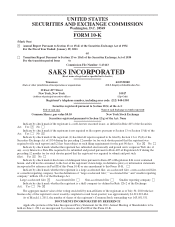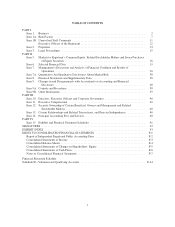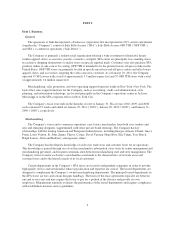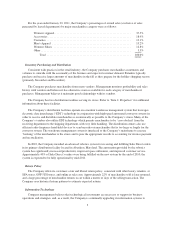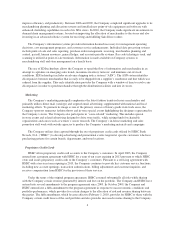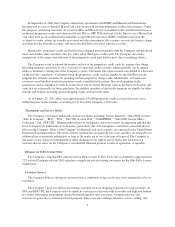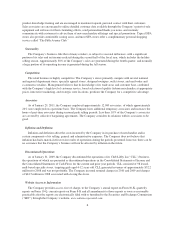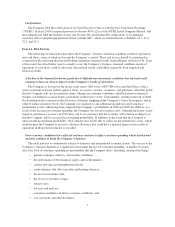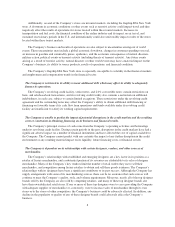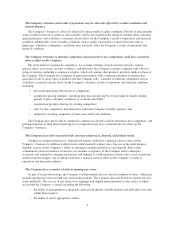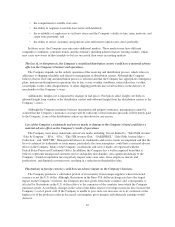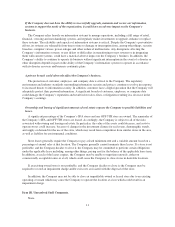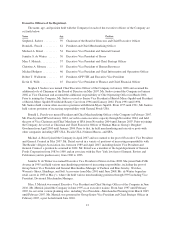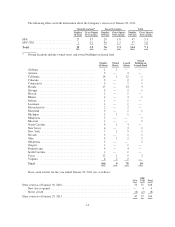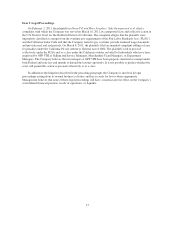Saks Fifth Avenue 2010 Annual Report Download - page 8
Download and view the complete annual report
Please find page 8 of the 2010 Saks Fifth Avenue annual report below. You can navigate through the pages in the report by either clicking on the pages listed below, or by using the keyword search tool below to find specific information within the annual report.Certifications
The Company filed the certification of its Chief Executive Officer with the New York Stock Exchange
(“NYSE”) in fiscal 2010 as required pursuant to Section 303A.12(a) of the NYSE Listed Company Manual, and
the Company has filed the Sarbanes-Oxley Act Section 302 and Section 906 certifications of its principal
executive officer and principal financial officer with the SEC, which are attached hereto as Exhibits 31.1, 31.2,
32.1, and 32.2.
Item 1A. Risk Factors.
The following are risk factors that affect the Company’s business, financial condition, results of operations,
and cash flows, some of which are beyond the Company’s control. These risk factors should be considered in
connection with evaluating the forward-looking statements contained in this Annual Report on Form 10-K. If any
of the events described below were to actually occur, the Company’s business, financial condition, results of
operations or cash flows could be adversely affected and results could differ materially from expected and
historical results.
A decline in the demand for luxury goods due to difficult macroeconomic conditions has had and could
continue to have an adverse impact on the Company’s results of operations.
The Company is focused on the luxury retail sector. SFA stores, OFF 5TH stores and Saks Direct offer a
wide assortment of luxury fashion apparel, shoes, accessories, jewelry, cosmetics, and gift items. All of the goods
that the Company sells are discretionary items. Changes in consumer confidence and fluctuations in financial
markets can influence cyclical trends, particularly in the luxury sector. Consequently, starting in the fall of 2008,
the downturn in the economy resulted in fewer customers shopping in the Company’s stores. In response, and in
order to reduce inventory levels, the Company was required to take additional markdowns and to increase
promotional events, which negatively impacted the Company’s profitability in 2008 and 2009. In addition, as a
result of the decrease in consumer spending, the Company was forced to reduce costs. Although the luxury sector
began to experience a recovery in 2010, there can be no assurance that the economy will continue to improve or
that the Company will be successful in sustaining profitability. In addition, in the event that the Company is
unsuccessful in sustaining profitability, the Company may not be able to realize its net deferred tax assets, which
would require the Company to record a valuation allowance that could have a material impact on its results of
operations in the period in which it is recorded.
Poor economic conditions have affected and may continue to affect consumer spending which has harmed
and may continue to harm the Company’s business.
The retail industry is continuously subject to domestic and international economic trends. The success of the
Company’s business depends to a significant extent upon the level of consumer spending. A number of factors
affect the level of consumer spending on merchandise that the Company offers, including, among other things:
• general economic, industry, and weather conditions;
• the performance of the financial, equity, and credit markets;
• current and expected unemployment levels;
• crude oil prices that affect gasoline and heating oil prices;
• the level of consumer debt;
• the level of consumer savings;
• interest rates;
• tax rates and policies;
• consumer confidence in future economic conditions; and
• war, terrorism, and other hostilities.
7

